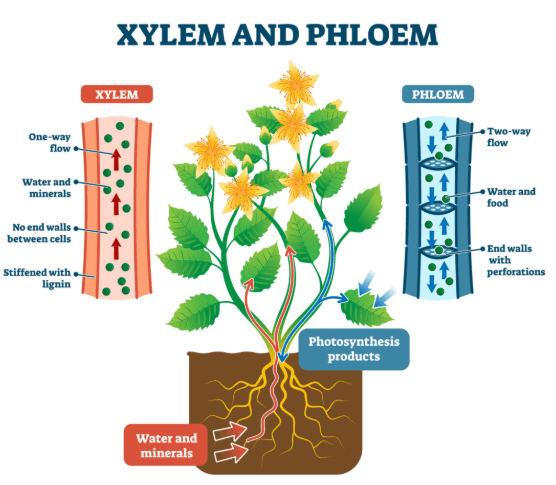How Are Water and Minerals Transported in Plants?
A Complete Guide for NEET, JEE, and CBSE Students
Water and mineral transport in plants is a vital process for survival, growth, and photosynthesis. This mechanism ensures nutrients reach every part of the plant, from roots to leaves. In this article, we’ll explore the key concepts, processes, and examples to help you understand how water and minerals are transported in plants, especially for Class 10, NEET, and JEE aspirants.

1. Overview of Water and Mineral Transport
Plants absorb water and minerals from the soil through their roots. These nutrients are then transported upwards to the stems, leaves, and other parts via specialized tissues called xylem and phloem.
Key Concepts:
- Absorption: Roots absorb water and minerals from the soil.
- Transpiration: Water evaporates from leaves, creating a suction force.
- Capillary Action: Water moves upward through narrow xylem vessels.
- Root Pressure: Forces water upwards from the roots.
2. The Role of Xylem in Water Transport
The xylem is a specialized vascular tissue responsible for transporting water and dissolved minerals from the roots to the rest of the plant.
Process Explained:
- Root Absorption: Root hairs increase surface area for water uptake.
- Osmosis: Water moves into root cells due to differences in water potential.
- Xylem Transport: Water moves upwards through tracheids and vessels.
- Transpiration Pull: Evaporation from leaves creates a suction force.
NEET/JEE Tip:
Remember: Cohesion-Tension Theory explains water movement in xylem. Water molecules stick together (cohesion) and are pulled upward by transpiration.
3. Mineral Transport in Plants
Minerals are absorbed as ions and transported through the xylem along with water. Unlike water, minerals require active transport because they move against concentration gradients.
Active Transport
Energy (ATP) is used to pump minerals into root cells against their concentration gradient.
Passive Transport
Some minerals diffuse along with water (mass flow) without energy expenditure.
4. Differences Between Xylem and Phloem
| Feature | Xylem | Phloem |
|---|---|---|
| Function | Water & mineral transport | Food (sugar) transport |
| Direction | Unidirectional (upwards) | Bidirectional |
| Mechanism | Passive (transpiration pull) | Active (energy required) |
FAQs About Water and Mineral Transport in Plants
Q1: What is the role of root hairs in water absorption?
Answer: Root hairs increase the surface area of roots, enhancing water and mineral absorption from the soil.
Q2: How does transpiration help in water transport?
Answer: Transpiration creates a suction force (transpiration pull) that draws water upward through the xylem.
Q3: Why is active transport needed for mineral uptake?
Answer: Minerals are often in lower concentrations in soil than in plant cells, so energy (ATP) is required for uptake against the gradient.
Summary
Water and minerals are transported in plants through a combination of root absorption, xylem transport, transpiration pull, and active transport. Understanding these processes is crucial for NEET, JEE, and CBSE Class 10–12 exams.
Got questions or thoughts? Share them in the comments below!


